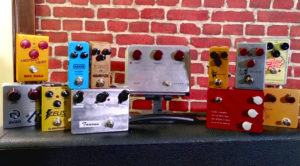
Few pedals exist out there whose legendary status and hype have peaked as high as that of Klon’s Centaur overdrive. This pedal, worth a couple

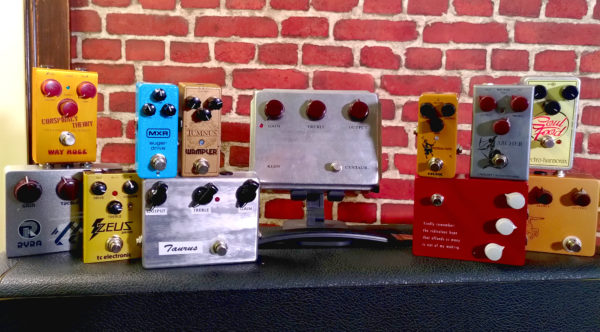
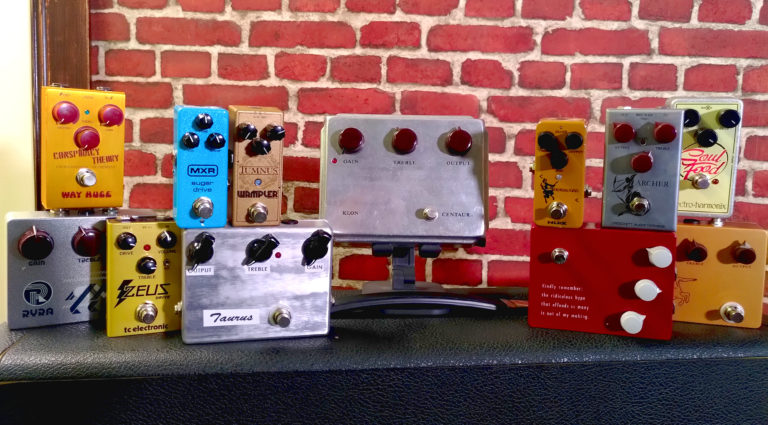
Few pedals exist out there whose legendary status and hype have peaked as high as that of Klon’s Centaur overdrive. This pedal, worth a couple of hundred bucks when it first came out, is currently sold online for over two thousand dollars, making it more expensive than legendary fuzzes such as the Big Muff Pi, Fuzz Face, and Tonebender.
So what makes the Klon a one-of-kind pedal? Why is its sound so coveted and why does its construction still spark endless debates online? Or have the “klones” in fact achieved a perfect replica over the years? We want to take you with us on an exploration trip, investigate what all the talk is about, and then let you judge by your own ears. Meanwhile, in the last thirteen years the market has been flooded with replicas of the Klon (Klones) coming from both boutique and big player manufacturers.
If you look around for information about how it all started with the Klons, you’ll soon find the same story repeated over and over, like one of those tales grandfathers pass on to their grandchildren during long nights in front of the fireplace.
Once upon a time, there was aguy in Massachusetts. The guy was a musician, specifically, a guitar player. Like many guitar players, our guy often toured around bigger and smaller venues, where he could make his music heard by local audiences. But his adventures often encountered technical difficulties: the smaller venues would not allow him to play his Telecaster through a pushed amplifier, and all the harmonic magic of his Fender Tweed Twin would get lost at lower gains. And the guy decided to do what real heroes do: he took his destiny in his own hands, and created a mythical overdrive pedal which allowed a clean but rich boost of his guitar tone even at very low amplifier levels. And just so, the Klon’s Centaur was born.
In fact, when in the early 90s Bill Finnegan found himself in need of a way to get around the volume constrictions of the smaller locations where he was often playing, he didn’t have much choice. At this point in history the main alternative to pushing an amp was to use the famous Ibanez Tubescreamer. Bill set out to do just that, but after playing around with various available models he just couldn’t make peace with the characteristic mids bump that is the Tubescreamer’s sound signature. Instead of compromising what he felt was the right tone for his music, he decided to create his own solution to the problem. He teamed up with an MIT graduate (Fred Fenning), and together they created the original design which was soon to be known as the Klon’s Centaur.
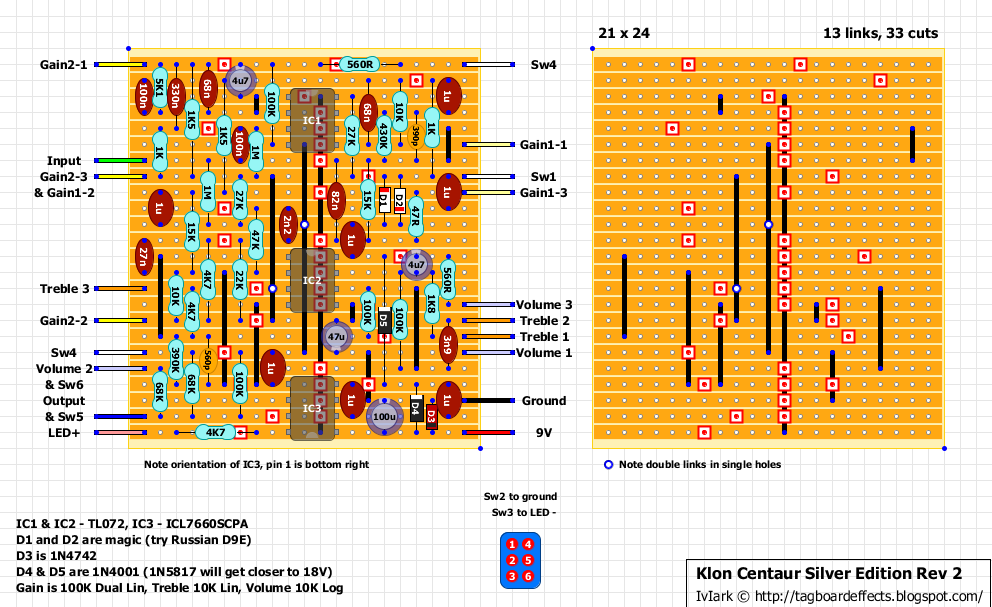
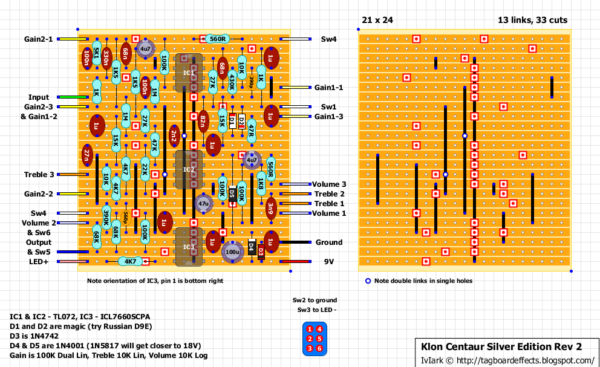
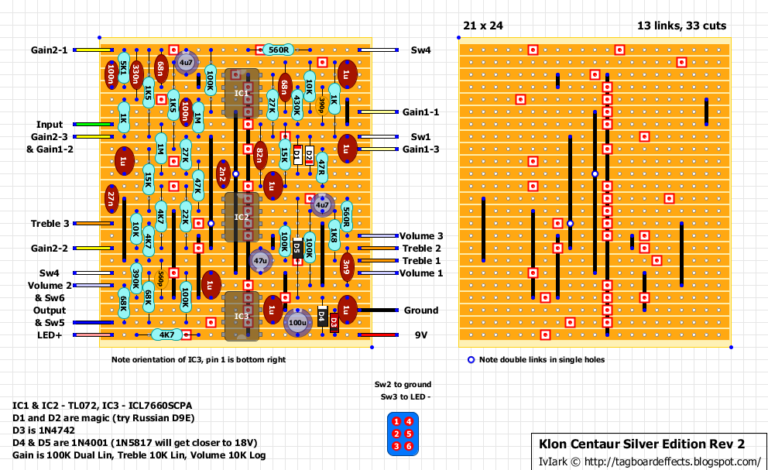
The first pedal units, all hand-assembled by Finnegan himself, were released on the market in 1994 for $225, and were positively received by the musicians community. Off with a bit of a slow start, soon sales started gaining traction as the pedal reputation steadily increased through word of mouth. As the manufacturing process was still (literally) in Bill Finnegan’s hands, a waiting list started to build up, while the combination of scarcity and notoriety pushed the price up and up. In 2007, you would have to wait 9 weeks for a Klon’s Centaur shipment, and the price per unit amounted to $329.



During the lifetime of Klon’s Centaur production, a big factor in its growth was the mystery surrounding its circuit. Each unit’s circuit had been coated in epoxy (a black, hardened resin), a smart move which made it very difficult to reconstruct the pedal’s schematics and therefore copy it. However, the ploy couldn’t last forever. In 2009 some users from freestompboxes.com bought a used Centaur and sent it to Martin Chittum, who with great patience was able to remove the goop and to finally release the schematics of this pedal (more on this later). By the end of the year, a number of cloned pedals, or “Klones”, had already appeared on the market, and Bill Finnegan had decided to end Klon’s production entirely. The mythical Centaur has since been gone from the market, but in 2014 Finnegan came back with a new, surface mounted version which is said to reproduce to 100% the original circuit of the pedal – the KTR Klon.
We will discuss this famous circuit and the myths surrounding it, the new Klon version, as well as some of the Klones on the market in more detail in the following sections. Meanwhile, you can start by listening to the legendary sound of the original Centaur in the player below!






The big hype and mythical status behind the Klon Centaur (and whether or not any other pedal will ever equal it) has largely to do with its once mysterious, epoxy-covered circuit. The 2009 Klon-gate revealed an entirely original design, and not a tweak on an already existing overdrive circuit, which many thought it was at the time. In fact, far from being basic, the circuit incorporates a few interesting and relatively uncommon solutions in its signal flow, which account for much of the Centaur’s tonal character. For those acquainted with block diagrams and electronics, Electro Smash gives a great walk through of the whole thing on their website. Here are some highlights we think worth mentioning, as well as some points central to existing debates.



The power supply of the Klon Centaur features a relatively complex voltage converter. It creates a variety of voltages which are used at different stages of the circuit and contribute to create the signature sound of this pedal. In particular, the last stages of the pedal use a +18V and a -9V voltage: this doubles the headroom and is also used to add slew-rate to the OP-amp. Translated, this means that these voltages allow for a very faithful reproduction of dynamics, as well as a quicker response to faster guitar signals and higher frequency harmonics.
Contrary to many modern effect pedals, the original Klon Centaur isn’t built with a true bypass function. Instead, whenever the pedal is “off”, the guitar signal still goes through the input part of the circuit, which includes an OP-amp (Operational Amplifier link) acting as a buffer. This means that the impedance is high at the OP-amp input and low at its output, reducing the capacitance of the signal coming from the guitar cable into the pedal. For the layman, the result is that the signal maintains its high frequency content even over longer cables or busy pedalboards. In addition, the lack of resistors controlling the gain of the OP amplifier ensures that the level of the signal isn’t changed between its input and output.
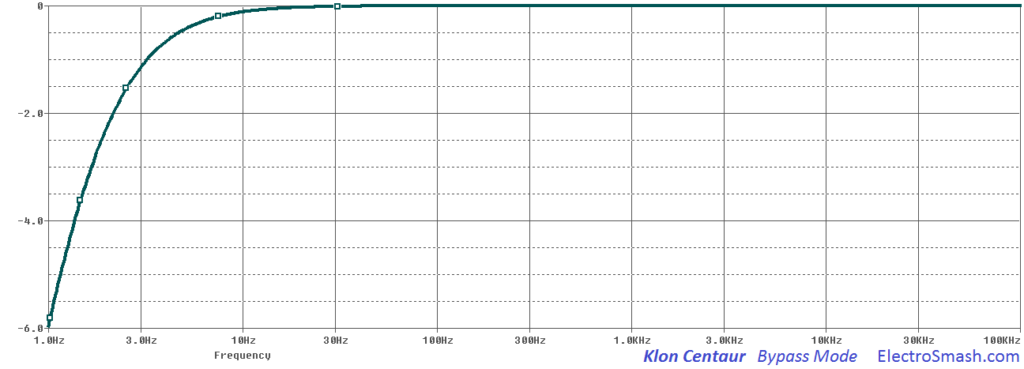
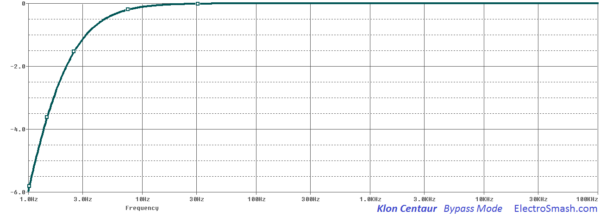
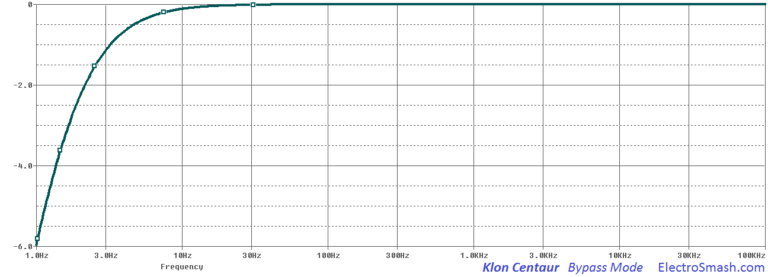
When the pedal is on, the complexity of the Centaur circuits comes fully into play. Past the input section, a splitter divides the signal into three different parts of the circuit:
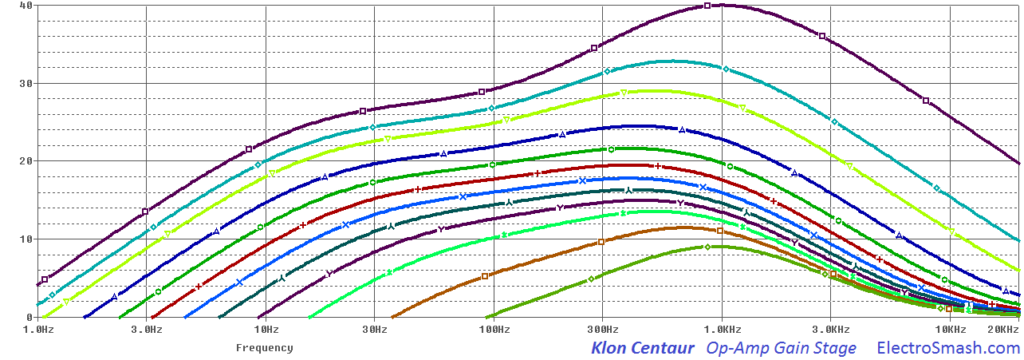
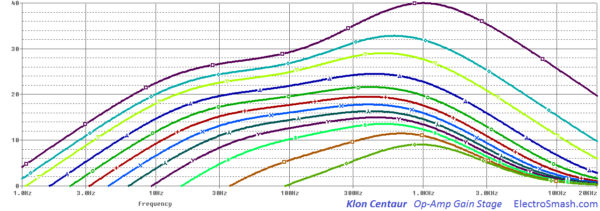
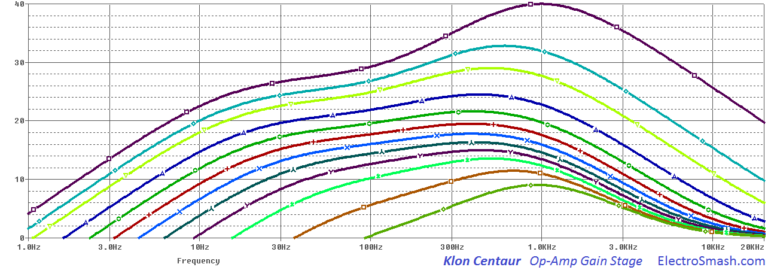
The three parts of the signal are finally summed up in a third OP Amp, where the mix between the clean parts and the saturated one generates a signal that is distorted yet still highly dynamic. It’s what is often referred to as the transparent overdrive of the Klon Centaur. The amount of gain introduced by this op-amp is very high, around 100 dB, as it results from gain applied to each of the three signal parts.
In addition, a filter positioned at this stage accentuates the mid-hump boost a bit more, by attenuating frequencies over 495 Hz.
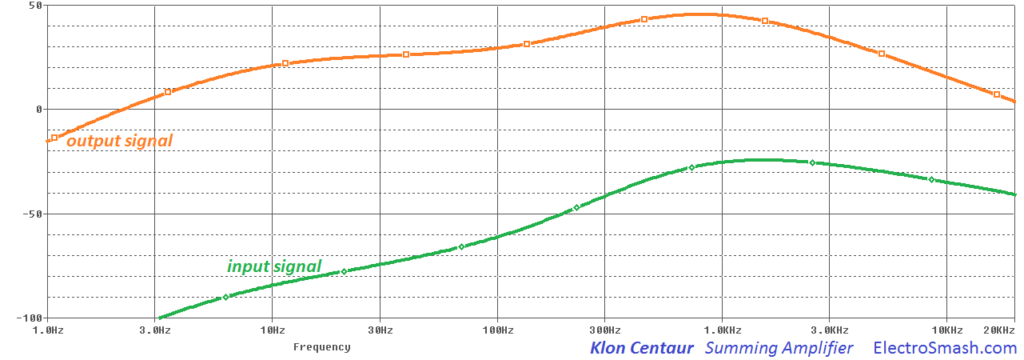
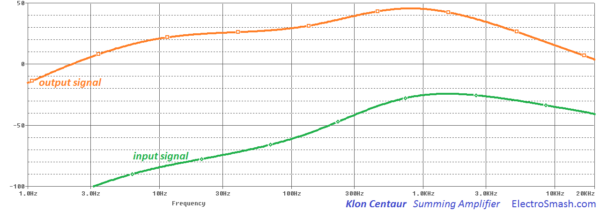
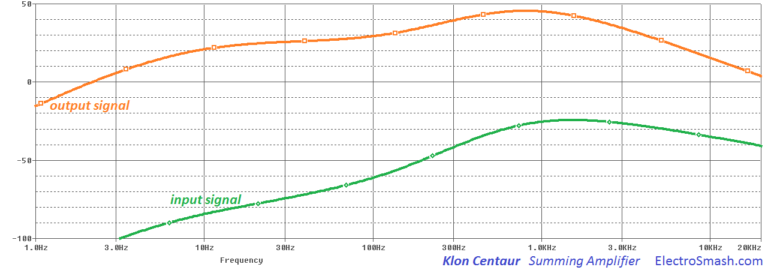
A huge chunk of the debate that has raged around the Klon Centaur schematics for years, has to do with the pedal’s most famous components: a couple of germanium clipping diodes.
A diode is a type of semiconductor, a component which under certain conditions lets electricity flow, and under certain others conditions, does not.
In the case of a diode, it will conduct electricity whenever a higher voltage is applied to its anode (+) than to its cathode (-). For this to happen a minimum difference in voltage first needs to be reached, this is called the diode forward voltage. For the Centaur’s germanium diodes, the forward voltage was measured at 0.35V when the circuit was first revealed.
According to Finnegan, “These diodes are the most important factor in how the circuit sounds when it’s being used to create distortion”. Both germanium diodes used in the original Klon are set-up in a symmetrical, hard clipping fashion with two opposite polarities going from the signal path to ground. They are placed in the circuit right after the OP-amp in the saturating section, and their clipping behavior is increasingly triggered as the output gain of the OP-amp increases. The choice of germanium versus silicon diodes is responsible for a more gradual onset of the clipping behavior, as well as for its comparatively softer character.
The tone control on the Klon Centaur consists of an active high pass shelving equalizer, which can boost (max ca +18 dB) or cut (min ca -8 dB) all frequencies over 408 Hz.
The output stage is a simple potentiometer, with a considerably flat response across the frequency spectrum.
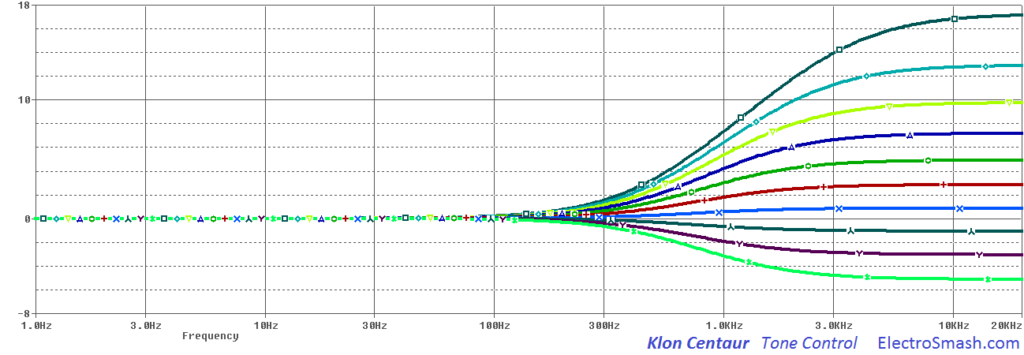
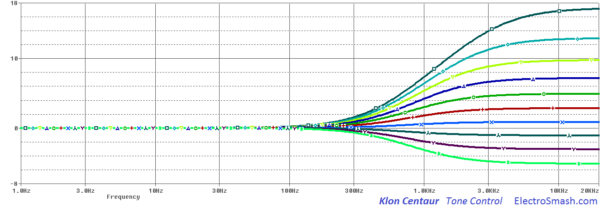
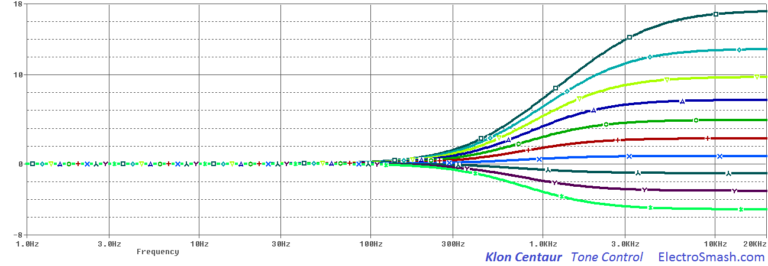
However big of a setback the leak of the Centaur’s schematics may have looked, Finnegan did not remain idle for long. Almost immediately after closing the first Centaur production, he began redesigning his own pedal into a new form – one that would allow him to hire contractors for its manufacture and that would be easy to repair, while remaining 100% true to the original Centaur sound.
Word of this new, renewed, miraculous second son already got out in 2010, but it wasn’t until four years later that Klon KTR Centaur finally launched for the relatively modest price of $269. The new design featured surface mount components, standard Boss style DC jack, the option to switch between true and buffered bypass, and, of course, the original germanium clipping diodes. On the sleek, red surface, in lieu of the original horseman picture, is a witty epigram in white lettering, Finnegan’s own humorous signature.
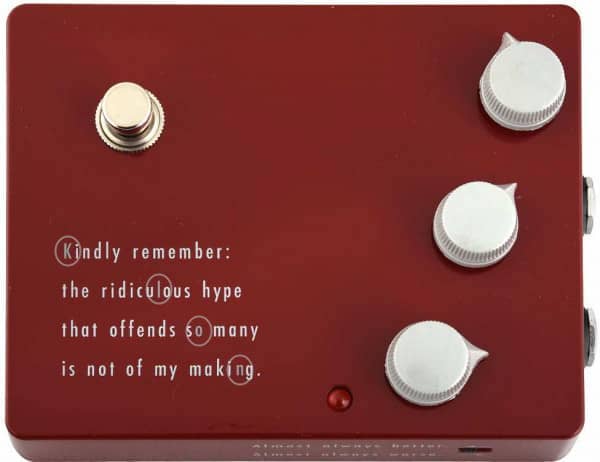


As was expected, a debate immediately fired up around the KTR release: does the new pedal sound identical to the original one or not?
In Finnegan’s opinion, most of the doubts arise from the fact that KTR uses surface-mount parts, instead of the through-holes built of the original Centaur. However, in his opinion, this does not translate into any significant difference. In fact, as he declared in an interview: “For two years my assistant, John Perotti, and I listened to hundreds of different surface-mount parts throughout the circuit … While it wasn’t an easy or pleasant process, we both feel—and now a lot of other people feel, as well—that I achieved my design goal: With careful component selection, the KTR sounds the same as the Centaur.”
Meanwhile, as announced at the end of 2021, Finnegan’s stache of “magic” germanium diodes is finally running out, meaning future batches of Klon KTR will use substitute parts. Until then however, you can let your ears judge if the KTR really hit its mark as a completely faithful reproduction of its predecessor: just hit play and compare the two pedals in the player below!






Already in 2007 the Klon market had exploded. The official retail channels had waiting lists of eight or nine weeks before shipping, while on ebay the second hand market prices had sky-rocketed to several hundreds dollars more than the price of a new unit. Understandably, as the hype increased, the curiosity around the mysterious, epoxy-covered circuit also kept growing.
As mentioned earlier, by 2007, the thirst for knowledge became so great that eighth complete strangers, who had only met on the chat boards of a DIY forum called freestompboxes.com, decided to go on a quest: they would put some savings together, purchase a second hand Centaur, reveal the circuit under the epoxy, and reverse engineer the whole pedal function.
The quest ended taking much longer than initially expected – almost two years – but it was exactly how the pedal finally ended in the hands of Mike Chittum and how its schematics was made public and free for the world to see on the same forum that had initiated the whole adventure. In a matter of months, the market started to be swarmed with clones or, as they started soon to be called, Klones.
Today, there are tens of Klones out on the market to be tried and bought for much less price and effort than sourcing the original, or even the KTR, which too now fetch a lot on the second hand market. The JRAD Archer was the first one to be released as 100%, part-by-part reconstruction of the original pedal, and to this day it is regarded as one of the closest results in achieving the original sound. It is even rumored that this specific design might have received input from Bill himself. Another high ranking contestant is Wampler Tumnus, which came out a year after the KTR and has achieved great success, partially thanks to its design as a mini pedal. A third name consistently coming up in the on-going discussions is that of Way Huge Conspiracy Theory designed by pedal legend Jeorge Tripps. Along with these, an ever increasing number of Klones are being released both by established names such as Electro Harmonix (Soul Food) and MXR (M 294 Sugar Drive Mini), TC Electronics (Zeus Drive), as well as by much less known sources, which often have the big advantage of offering highly competitive prices for their products (examples include Ryra The New Klone, Wish Klon Centaur Overdrive, TTONE New Klone). For the bravest, a number of ready-to-build pedal kits are also available to purchase online.
Do any of Klones live up to the legendary sound of the original one?
Luckily for you, you don’t have to rely on hearsay!
If there’s one thing we know how to do at Tonepedia, is to build meaningful comparisons of pedals, and we decided it was about time to get ourselves into some of this Klone madness. Below you can find 4 different interactive players, each with its own set of Klones and the original Centaur. All recordings were done using the exact same DIs and reamping settings, to guarantee the highest standard of objective comparability. On top of this, we have recorded and added animated visuals of some test tones sent through the pedals: now you can see the frequency response and clipping behavior while listening to it in real time.
Just hit play and play around with some of our features:
























Can the Klones ever compare in sound to the Klon Centaur?
The discussion at this point almost inevitably reverts back to the topic of the Germanium clipping diodes. This is because most of the components used in the Klon circuit, including the main, distorting OP amp, are relatively easy to find on the market. The same, unfortunately, cannot be said for the two clipping diodes.
The part number 1N34A gives an indication but is not of much use, as this denomination is used by a variety of manufacturers to label components that in audio circuits sound quite different from one another. Finnegan stated more than one time that during the circuit design process he bought and personally tried out about 70 or 80 variations of this type of diode, and that he was happy with only one of them. He then proceeded to buy as many of those exact diodes as he could find on the market, and has been using them ever since.
Reverse engineering doesn’t bring any certainty in this case. The closest to identifying the exact part one can get is to measure the forward voltage of the original diodes, and try to match it with that of another part. This was originally done when the circuit was first released, and the 0.35 V value was found. However, it has since been observed that measurements of diodes depend on the amount of test current used for the test, which is very different and yields different results when one uses a multimeter or a semiconductor analyser, as noted by Gray bench Electronics while Chittum used a multimeter when tracing the Centaur circuit, an MIT graduate such as Fennig is much more likely to have used a semiconductor analyser (for a full discussion of the Centaur Germanium clipping diodes see the GBE video below).
Finnegan has several times reiterated that no clone of his pedal will ever be able to achieve the original sound, as in his opinion the action of the diodes is fundamental to the circuit tonal response.
However, there’s a further consideration to be made from the point of view of the electronic components: with a forward voltage of 0.35 V, the germanium diodes do not even begin reacting until the OP-amp of the distorting stage is cranked up to higher settings (somewhere between 1 and 5 o’clock. You can find a demonstration of this in GBE video below). Until that point, the diodes are virtually cut off from the circuit, and make little to no difference in the sound whatsoever. This means that whenever the Klon (or any of its Klones) are used as a transparent booster, the only component contributing to the distortion is the OP-amp itself, which is simple to replicate in any of the cloned circuits.
So can people hear any difference when comparing the Klon to Klones?
Answers on debate forums and internet articles vary widely in this sense. Some people downplay any difference as neglectible or non-existent, others would swear by their ears that certain tone characteristics are not reproducible by any other pedal.
The truth might perhaps be that the question is not formulated well. In general, there are seldom two units, even of the same pedal, that sound exactly the same on the same settings, but you might be able to reproduce an exact sound by tweaking the setting a little differently on each unit. Also, slight differences in sound do not necessarily equate a better or worse quality. What seems quite clear from the hundreds of tests and comparisons out there, is that the specific quality of the Centaur Klon (if it indeed exists) is very difficult for users to point out clearly and separate from other tones during blind tests. Just have a look at the fun video that the guys at Andertons made.

Few pedals exist out there whose legendary status and hype have peaked as high as that of Klon’s Centaur overdrive. This pedal, worth a couple

As the first guitar pedals hit the market back in the 1960s, they did it as encumbering, hefty boxes that looked as gritty as they

We’ve all fallen in love at some point in our life with a well-modulated guitar sound, likely more than once. It’s something that goes beyond

How to nail the John Frusciante Guitar Tone Get “That” tone with our guide John Frusciante has never been known for wild, million notes per

Everyone knows that electric guitars and guitar amplifiers are as much an inseparable duo as Batman and Robin – plug the former into the latter

Where to buy guitar pedals Often the answer to, where to buy guitar pedals, can be a fairly personal subject to your relative location, social